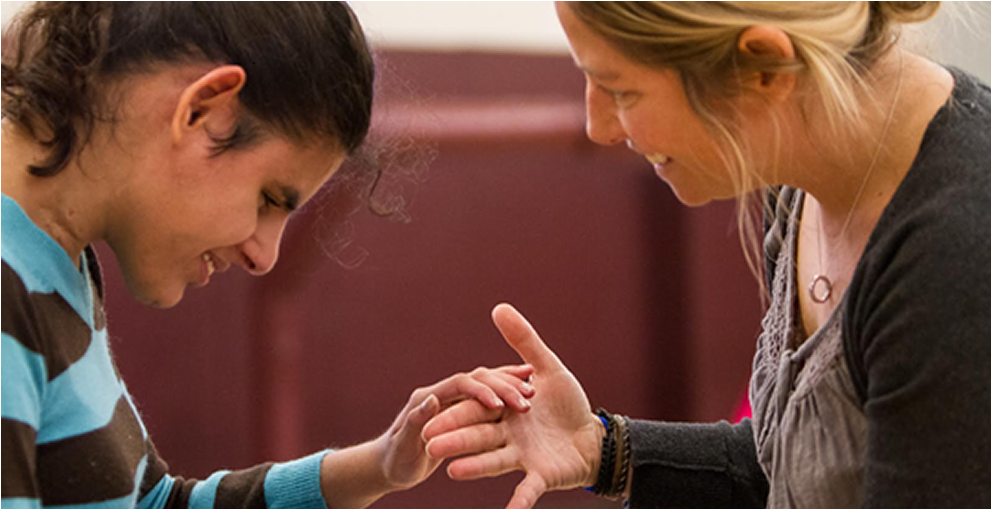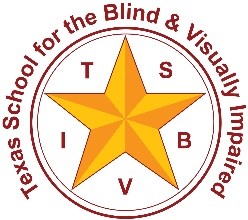Meaning Making
Question: How do we teach curiosity? Isn’t curiosity an innate attribute of all humans?
We perceive the world both as an individual and also as part of a whole – as what we do in the context of others. We explore our world, we think about it, process it, and form concepts and ideas from our experiences. It might be what we call thinking. Sometimes thinking manifests itself as an internal dialogue (dialogicality) , other times we do this thinking out loud with other people. We are social beings who are dependent upon the knowledge, concepts, and arguments from other people to help form our own concepts.
Jarvis and the Drum Store
As you watch this video, you will see Jarvis, who is a teenage boy with a moderate hearing loss and no functional vision. Notice that Jarvis and his intervener are using an FM system which allows better access to his intervener’s and teacher’s voices. Jarvis and his intervener are communicating through tactile sign language that is very specific to Jarvis; they are not necessarily using formal ASL. In addition to tactile symbols, she also uses a lot of body movement and gestures. Jarvis and his intervener are communicating in a “common mode”, one that has been co-created by Jarvis and his teachers over many years. It’s a language based on Jarvis’ unique ways of accessing and experiencing the world. The teachers are simultaneously communicating in his mode while also infusing their more formal mode into the conversation. Please refer back to the ideas of the double zone of proximal development and the development of a language which does not yet exist.
Deafblind Interaction Menu
Cultural Language of Congenitally Deafblind
As we have interactions and experiences in the world, we form social stories that make up the stories of our lives. These stories give us a time and place in the world. They offer context to our life and provide a sense of self. We then use artifacts to record our stories, e.g., pictures, video clips, and written journals. These artifacts provide us with some sense of permanence to our experiences. They provide a form for reminiscing with others. They provide permanence to our experiences and a static context to our oral stories.
Because people are social beings we need a way to share their stories, to record our version of the world and offer our experiences to others. All of this points to a need for a common language. A language produced under social circumstances, with other people.
Preparation for the Trip to the Drum Store
Before Jarvis leaves on this trip, he explores his tactile calendar with his intervener, to talk about the upcoming events of the day. Jarvis is able to anticipate and process familiar events in his day. He is able to attach labels and names for these events.
The calendar discussion also allows him to connect prior concepts and experiences to ones he may have at the drum store – it allows for meaning making. Matt, his teacher, is trying to help him understand the concept of “exploring” something or some place. While he may not know the meaning of all of these symbols prior to the trip to the drum store, he is beginning to make sense of the concept of exploring through the routine of going on a field trip in the van. His relationship with his teacher and his trust in this structure enables him to comfortably participate in the activity that makes meaning of the specific tactile symbol and sign for “drum store”. These symbols and signs may have limited meaning to him before the experience.
Exploring the Drum Store
When he arrives at the drum store, he’s intrigued and also a bit afraid. It’s an emotional experience for him. When Matt hits a drum Jarvis pulls back, Matt notices, affirms, and labels his emotion, “You’re scared and I will help.” This is a very “human” thing: all of us need to know that we are seen and heard. The gestures and vocalizations that Matt uses are big and bold, they make use of rhythm and musicality, large bodily movements. Each of the various drums is labeled through different vocalizations and bodily movements that are unique to Jarvis, rather than Matt imposing his formal language. There is a strong bodily connection and resonance between Jarvis and Matt as they explore each musical instrument. The bodhran, the xylophone, and the kettle drum each evoke a specific set of movements and interactions between Matt and Jarvis.
Throughout the whole experience, Matt does not make any demands on Jarvis. Matt recognizes that Jarvis is at an early level of development emotionally and may feel stressed. Reducing demands helps to reduce stress.
Processing the Experience Immediately
Immediately after leaving the store, Jarvis and Matt sit in the van and review what they just experienced. Jarvis “listens” intently while Matt “speaks”. Matt recounts again what they did in the store through the same expressive gestures, and rhythmic musical vocalizations, while also referencing the symbols in Jarvis’ book. Matt and Jarvis are co-creating language in the moment. Jarvis needs this time to reflect, formalize the language, and connect these new words and experiences to things he already understands.
Reviewing the Experience Two Days Later
Two days later when back at school, his joy is evident as he shares the experience with Tish (his speech language pathologist) who wasn’t a part of the experience. Notice the way Jarvis moves his hands while Tish is reading his book using the same sounds and movements he and Matt used in the van. It seems he is thrilled that Tish somehow knows what happened. The same tactile symbols that are in his calendar, are used in his book – an expressive form of communication. This is a way to reminisce, while also being a step towards greater literacy skills.
The Importance of Emotional Tension
Pay particular attention to the emotions that are expressed and shared between Matt, Jarvis, and Tish as you watch this video. We see Jarvis move through a range of emotions from anxiety, to fear, to curiosity, to joy. We might call this “emotional tension”. Emotion helps make our everyday experiences become significant and thus memorable. Emotion enables the everyday event to be processed, remembered, and retold. Gunnar Vege calls this “moving from meaningful to significant”.
When Jarvis and Matt enter the drum store, Jarvis holds himself more rigidly than when he was in his familiar routine with the intervener. He stays very close to Matt, his trusted person. When Matt hits the large drum, Jarvis startles and makes a vocal sound. Matt immediately affirms Jarvis’ communication and says “Jarvis you’re scared”. He attaches a label to the emotion. Later, as Jarvis shares his story with Tish, you can see how happy he is. They also talk about how Jarvis was “scared” at the drum store. Tish again affirms and labels his emotion. Imagine never being able to talk and share your emotional experiences because you didn’t have a partner with whom to communicate.
This example of the trip to the drum store illustrates how the process of “meaning making” and co-creation of language can happen through sharing an experience with a trusted person. The ability to share our experiences with other people is critical to our understanding of the world and our humanity.

“We cannot teach concepts through discrete lessons, but we can offer children experiences to help them develop concepts.”
Barbara Miles

